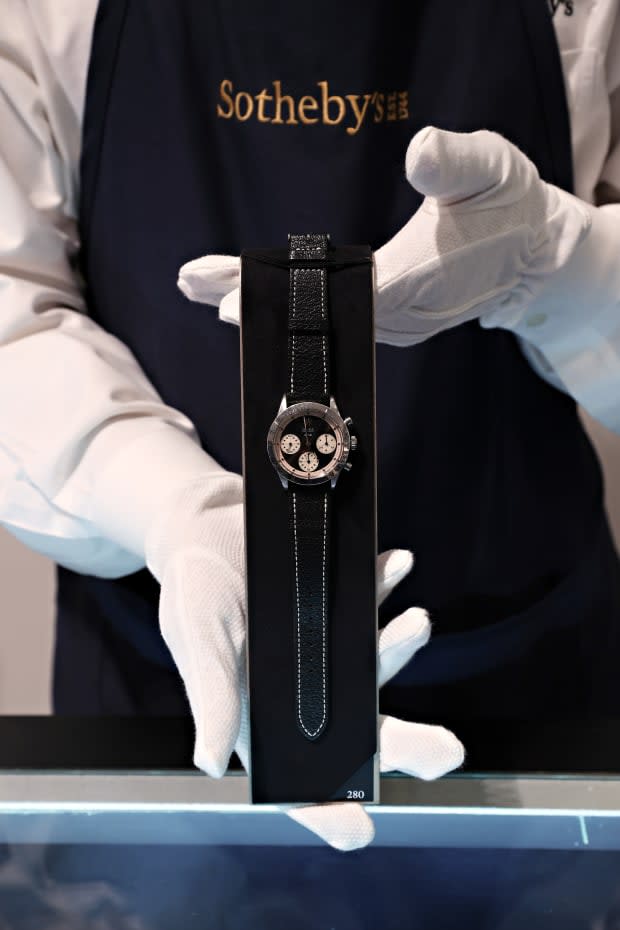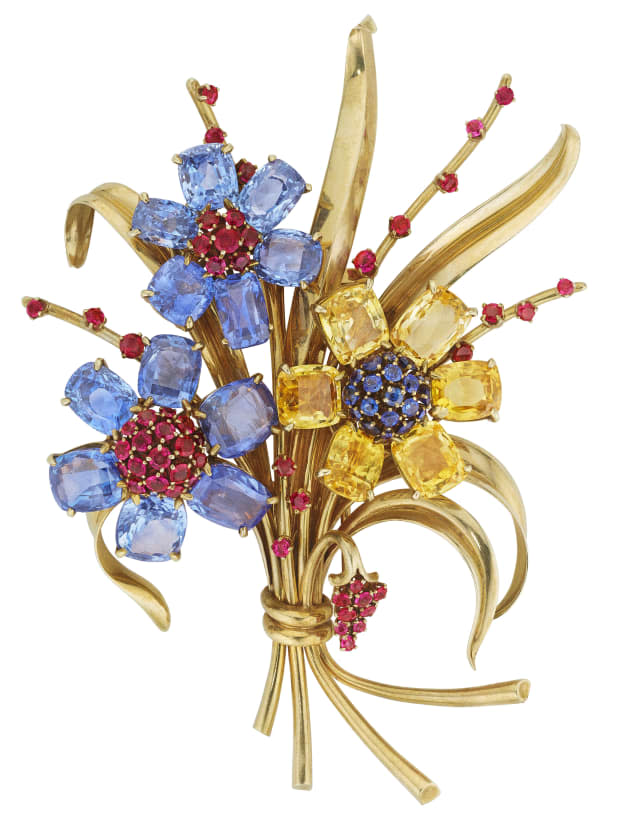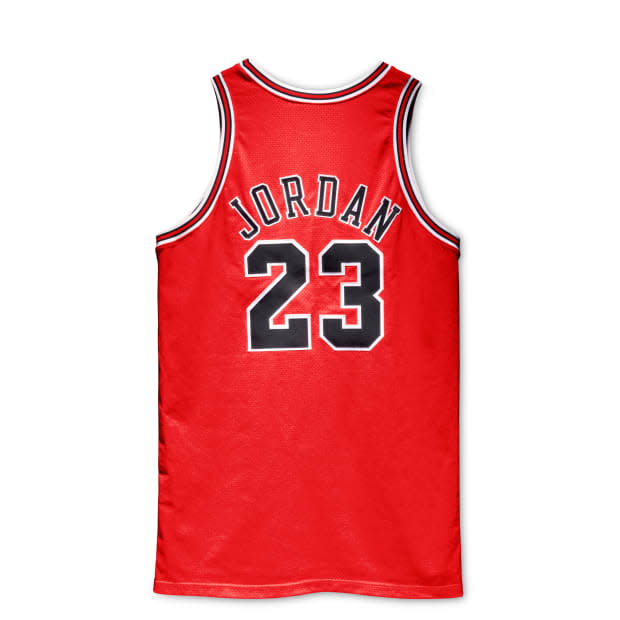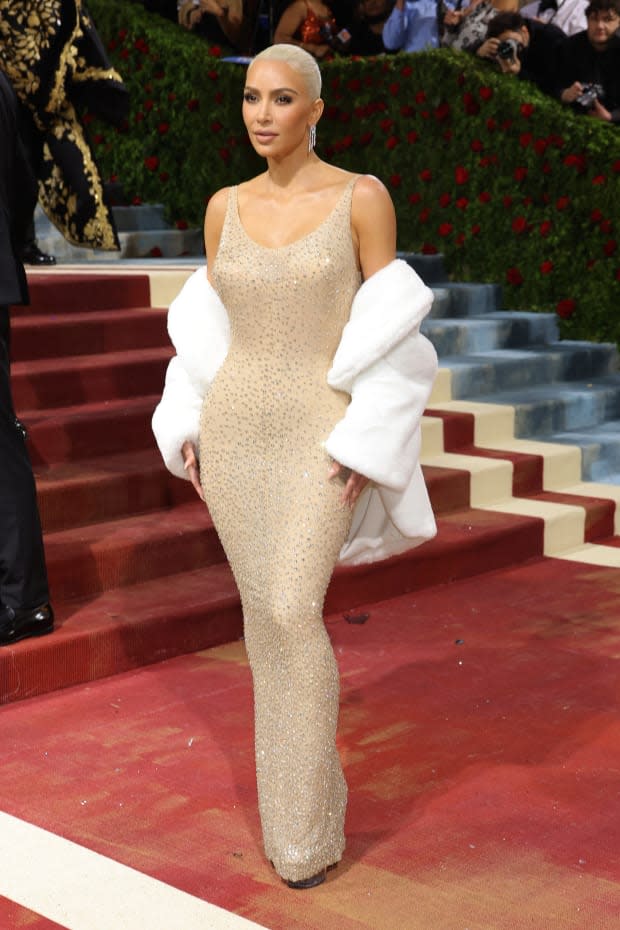For Auction Houses, Luxury Fashion Is the New Fine Art
- Oops!Something went wrong.Please try again later.
From handbags to sneakers to gowns once worn by Marilyn Monroe (and Kim Kardashian), special fashion items are fetching millions at Sotheby's, Christie's and more.
Ever dreamt of owning a Bulgari necklace, with a side of Basquiat? Or perhaps a limited-edition picnic Birkin to match your Patek Phillipe Calatrava? For those who appreciate the finer things in life, it's now possible to shop for all the above at once — with the right bid, that is.
Previously reserved for art world insiders, auction houses have become a hot spot for (ultra) luxury fashion. Christie's and Sotheby's — the two largest players in the space — have both hosted "luxury week" sales in New York City, showcasing the best of their luxury divisions, which cover everything from watches, jewels, handbags and sneakers to other invaluable collectibles. Christie's has been investing in the luxury fashion game since the early 2010s; earlier this year, it opened a new department dedicated to streetwear, sneakers and sports collectibles across music, fashion, culture and art. For its part, Sotheby's vowed in 2019 to turn its business into equal parts fine arts and luxury; in 2021, it reported revenues over a billion dollars from its luxury division, approximately one eighth of the company's total revenue.

Photo: Courtesy of Christie's
The intersection of fine art and fashion is nothing new — how many artists and artist estates have we seen collaborate over the years? — but there has been an uptick in crossovers, particularly at auction houses, in recent years. Whether it's Sotheby's collaborating with Loewe on a series of chestnut roasters or Christie's teaming up with Stadium Goods on a sale of Michael Jordan's sneakers, institutions that historically have been dedicated to the upper crust of art are expanding their portfolio to fashion. In doing so, they're applying their unique bidding frameworks to more types of luxury products.

Photo: Cindy Ord/Getty Images
"Luxury has certainly been part of our offerings, but it's becoming more and more top of mind to clients and collectors around the world," says Rachel Koffsky, the international department head for handbags and accessories at Christie's. (The first handbag the auction house sold sold was a piece from Coco Chanel's collection in 1978.) "And the art market, the fashion market, the luxury market and pop culture have really convened."
The auction model offers a new angle through which to appreciate fashion, elevating it to the status of art (a topic people love to debate). Within these houses, each item in the inventory goes through meticulous appraisal, evaluated based on the brand, the model, the material, the production run, the provenance and so on, all of which add to value.
For Julien's Auctions, an auction house focused exclusively on celebrity memorabilia, there's also the matter of an object's history. "People look upon guitars or fashion or designer purses as works of art," says Martin Nolan, the company's executive director and CFO. "These three-dimensional items are just as important to collectors as those who buy Warhols or Picassos or Monets."
In the broader resale market, a similar set of criteria helps determine how something is priced. At an auction house, a fashion item will carry a much heftier price tag than it would at a consignment store; some items go for upwards of a million dollars (or, in the case of a magnificent fancy vivid pink diamond ring, over $58 million at Sothebys). However, there's an inherent difference: Within the auction space, fashion isn't simply lauded for its utilitarian purposes — it's viewed as a collectible, and maybe even an investment.

Photo: Courtesy of Christie's
According to Josh Pullan, head of the global luxury division at Sotheby's, there are a few different motivations driving purchases: There are people treating fashion items as "pure investment," others buying to actually use or gift, then those "looking for that hero piece that gets put on a shelf or in a perspective box and is revered as a trophy that never gets used." Sometimes, there's a personal connection. "People are buying a part of history or a part of their childhood," Pullan says, noting how this comes up a lot more in regards to pop culture or sports memorabilia.
Regardless of people's motivations for coming to an auction, one thing is for sure: Clients are consistently buying, which is a healthy indication of the market's faith in these assets' longterm value. Not only that, "we see value increase overtime," Pullan says.

Photo: courtesy of Sotheby's
When it comes to apparel, bidders seem to be swayed by whether a garment hung in a famous person's closet. For instance, a jersey worn by Michael Jordan in "The Last Dance" sold at Sotheby's for $10.1 million. Then, there's the case of the dress famously worn by Marilyn Monroe to sing "Happy Birthday" to President Kennedy: It was sold to an investor in 1999 for a then-world record of $1.2 million, before being sold again by Julien's Auction in 2016 for a whopping $4.81 million. The very same dress was recently worn by Kim Kardashian to the 2022 Met Gala — and because of that, Nolan believes it's "likely to sell for $10 million if it came to auction again."

Photo: Mike Coppola/Getty Image
In many ways, the meeting of these two lucrative businesses — fine art sales and luxury fashion — is natural. Christie's is owned by François-Henri Pinault, who also owns Kering, the luxury goods parent company of brands like Balenciaga, Bottega Veneta and Gucci. Meanwhile, LVMH's president, Bernard Arnault, briefly owned auction house Phillips in the 2000s.
Despite all this, luxury sales still only account for a portion of auction house's revenues. After all, handbags, jewelry and watches have relatively more approachable entry points than an old master painting. Yet, the lower price tag is precisely what drives interest among younger customers, who might otherwise be too intimidated by the auction world.
"We found that certain categories — like handbags, sneakers and whiskey — were great ways for bringing brand new clients into the business, new clients of a different age demographic as well," says Pullan. "We've seen them then purchase across categories into the art side of our business, and also the art side into our luxury business."
It's not outrageous to say luxury fashion could one day grow enough to sustain auction businesses in the future, especially as an emerging crop of collectors continue transcending traditional categories.
Never miss the latest fashion industry news. Sign up for the Fashionista daily newsletter.
